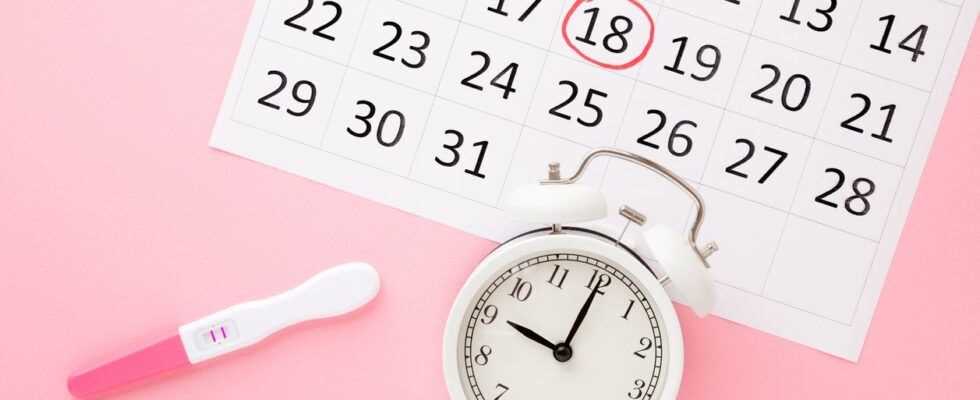A feeling of constant lubrication, swollen breasts, an exploding libido… What are the main symptoms of ovulation? We enlighten you!
For those who have missed sex education classes, ovulation is the time when the ovaries release an egg (which may fuse with a sperm). According to women, it usually occurs around day 14 of the menstrual cycle, that is 16 to 12 days before the start of your period. This phenomenon causes very specific symptoms, which can greatly help to see more clearly when you want to start a small baby, or on the contrary to avoid it. This is especially valid if the menstrual cycle is irregular, as the symptoms of ovulation can more or less indicate when you are most fertile.
Indeed, ovulation coincides with the peak of a woman's fertility, in other words the days when intercourse is the best time to get pregnant. Small qualification however, the accuracy of ovulation depends both on the regularity of the cycle, but also multiple psychological and emotional factors related to lifestyle.
During ovulation, a woman's body is subject to a series of physical changes, mainly due to a large increase in LH hormones and estrogen. This is why the physical symptoms that indicate that you are the most likely to get pregnant are many and varied.
1. Increased libido
During the two to three days before ovulation, a woman's libido increases. If you want to get pregnant, now is the best time to have sex. The sudden potency of sexual desire can sometimes be overwhelming, but be aware that it is simply due to the increase in estrogen in the blood, hormones produced by the ovaries.
When the ovaries reach their peak of estrogen production: libido increases. If you want to get pregnant, it is therefore THE best time to make love with your partner and maximize your chances. Envy shouldn't be a problem!
Getting pregnant: putting the odds in your favor
2. Cervical mucus is abundant and clearer
One of the main symptoms indicating that the period of ovulation is approaching is the change in vaginal secretions, and in particular that of the cervical mucus. This mucus, produced by the endometrial glands located on the cervix, changes in consistency depending on the period of the cycle in which the woman is. The difference in composition is clearly seen in the "infertile" period since the cervical mucus is thick and opaque. It also makes the survival of sperm more difficult.
As the days of ovulation approach, the amount and consistency of mucus produced by the cervix changes. The origin of this modification is a reduction in the acidity of the vaginal wall, which will then guarantee the survival of the spermatozoa and facilitate their passage through the tubes.
When ovulation is near, the mucus tends to become more runny, transparent and watery. On this occasion, you will notice a feeling of constant humidity and lubrication. The peak is reached on the last day of ovulation, when this flow has an almost liquid consistency. From there, it's the start of ovulation.
3. Basal temperature rises
Basal temperature represents the lowest temperature the body reaches while at rest. One of the symptoms that may alert you is its sudden increase during ovulation. This is caused by progesterone, the hormone the body produces in the luteal phase to help the fertilized egg nest in the lining of the uterus.
During the first phase of the cycle (period from the first day of menstruation to ovulation), the basal temperature is stable and generally below 37 ° C. It drops a few tenths just before ovulation to increase and exceed 37 ° C when it begins.
Read also: The temperature curve for getting pregnant: how does it work?
This indicator has its limits, however, since it does not allow you to know the precise and optimal time when you are most fertile. Since ovulation occurs when the temperature is still low, an increase is seen only when it has already occurred. However, it has the advantage of being sure that ovulation has occurred or if the cycle was anovulatory (a cycle without ovulation).
To control it, check your basal temperature as soon as you wake up, before you even get up.
4. Changes in the position of the cervix
In the days leading up to ovulation, which are the days when you are most fertile, your cervix is larger, softer, and more open. This physical symptom is not visible, but can be very helpful for specialists monitoring your cycle. Through scintigraphy cervical mucus, collecting cervical mucus can also tell if you are ovulating.
5. Swelling of the chest
As ovulation approaches, changes in the breast area may be seen. Your breasts will likely be softer, bigger, and harder, which can even cause a bit of discomfort. This is all due to the increased levels of hormones in the blood, usually responsible for relieving breast tenderness. Changes in the breasts are a good indicator of whether ovulation is in progress.
How do you calculate your ovulation date?
If you have a regular period, calculating your ovulation date is very easy. The preovulatory phase begins on the first day of your period (first day of your menstrual cycle) and ends with the release of the egg (onset of ovulation) which occurs around day 14 of your cycle. The post-ovulatory phase then begins, and lasts until the end of the cycle.
To calculate your ovulation date, it's here.
With this calculation, you should be able to pinpoint your ovulation period accurately to within a few days. Also, stay open and attentive to the signs your body is sending you. As you learn to recognize and understand them, you will notice that it makes your job much easier! This observation is obviously valid for those who want to get pregnant and those who do not.
